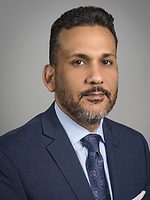Eric Clay: Addressing Healthcare Security Challenges
How does Eric Clay, System Director of Public Safety for CoxHealth, address common healthcare security challenges, and what initiatives has he taken to improve the safety of staff and patients?


“Although I don’t play a hands-on role in patient care, I believe the Public Safety Department provides a safe and secure environment that allows are clinical staff to provide the lifesaving care that they do,” says Eric Clay, System Director of Public Safety for CoxHealth.


"I have always sought opportunities to serve others, so I guess it’s easy to see how my background includes a stint in the U.S. Army, after which I went into law enforcement,” says Eric Clay, MSc, CPP, CHPA, CHPP, System Director of Public Safety for CoxHealth. Based in Springfield, Mo., CoxHealth is a large, not-for-profit healthcare system that comprises six hospitals and has primary and specialty care providers located in more than 80 clinics.
Throughout his career, Clay has been fortunate to work for great agencies, including the St. Charles, Mo. Police Department, the Orlando, Fla. Police Department, the Orange County, Fla. Sheriff’s Office, the U.S. Federal Air Marshal’s Service and the Christian County Sheriff’s Office, Mo. He has also consulted for a number of government agencies and private companies.
For the last five years, he has served as the System Director of Public Safety for CoxHealth. “This is a role I feel very fortunate to have, as CoxHealth truly does some great work in the community, and it’s based in my hometown, so I am able to spend time with my family, something I wasn’t able to do for many years,” he says.
What he likes the most about the healthcare sector is the “opportunity to work for an organization that truly makes a difference in many people’s lives. Although I don’t play a hands-on role in patient care, I believe the Public Safety Department provides a safe and secure environment that allows our clinical staff to provide the life-saving care that they do,” he says.
Mitigating Workplace Violence
Providing a safe and secure environment where clinical staff can focus on administering excellent patient care requires the CoxHealth Public Safety team to address all challenges head-on. One of those challenges includes workplace violence.
According to a 2016 GAO study, Additional Efforts Needed to Help Protect Health Care Workers from Workplace Violence, rates of violence against healthcare workers are 12-times higher than rates for the overall U.S. workforce, and 70 percent of nonfatal workplace assaults in 2016 occurred in the healthcare and social assistance sectors.
“From verbal abuse, to physical assaults, healthcare workers face threats on a daily basis, all while providing care for their patients,” Clay says.
CoxHealth has “an extremely effective workplace violence program that is recognized throughout the state. It involves a clear policy, mandated reporting to ensure we understand the scope of the problem, continuous training to help employees identify potential escalating behaviors early on, panic buttons, de-escalation and physical skills and community education,” Clay says.
For Clay, potential challenges that may contribute to a violent situation include:
- Reduced inpatient behavioral health beds for high acuity patients.
- Relatively unrestricted movement throughout hospital facilities.
- Overcrowding in jails, leading to law enforcement agencies relying on hospitals as places of care for acutely disturbed or violent individuals.
- An over-reliance on ERs, which leads to longer wait times and increased tensions.
- Opioid epidemic, which is leading patients to resort to violence or not have the rationale to avoid committing violent acts.
In addition to enforcing strict reporting policies, another initiative Clay and his department are proud of is a full-time Training Center, which is one of the first healthcare-specific training centers in Missouri that provides training to CoxHealth officers, local law enforcement agencies, other hospitals and colleges.
The Training Center provides more than 160 different classes, such as opioid overdose reversal with Narcan, “Stop the Bleed,” first aid, internet safety, self-defense classes and a kidnap-proofing class for children. For law enforcement officers, training includes firearms, traffic stop, defensive tactics and others to help them be better equipped to protect themselves and the public.
Clay and the CoxHealth department of Public Safety are working with the Missouri Hospital Association on a public campaign of education, as well. The goal of the campaign is to spread awareness that assaulting a healthcare worker is a crime, Clay says. “We have also met with local law enforcement agencies and prosecutors to further work on the issue.”
Another initiative Clay and the Public Safety team at CoxHealth are taking on is a K-9 Program. The program’s goal is to provide enhanced security and safety for staff and patients. “We’re hoping the K-9 program is going to be a visible deterrent to people who are acting aggressively in our facilities. We hope it is a de-escalation tool, that it serves as a comfort animal and that people feel protected by its mere presence,” Clay says.
Perception is Reality
“We have all heard the expression, ‘Perception is reality,’” Clay notes. “Ultimately, perception can influence the success of your brand, so for me, it is very important to cultivate it.”
CoxHealth’s Department of Public Safety has served for years as a visible deterrent to criminal activity and a resource to visitors, patients and employees, he notes. To maintain and lead a successful team is part of cultivating the perception of his brand.
One of the first initiatives Clay embraced as part of maintaining that perception was to rebrand the department by:
- Unifying all hospitals with one uniform, and common policies and procedures.
- Conducting an evaluation of the Public Safety Department, looking for areas to improve.
- After the assessment, policies and procedures were developed to ensure they reflected current thinking, mandated ongoing training and required certifications from the International Association for Healthcare Security and Safety (IAHSS) for all security officer personnel.
“It was important that we have a uniform that was easy to identify and that conveyed professionalism,” Clay says.
He adds that the Public Safety team are fortunate to have support for their security program at “all levels of the organization, at each campus. Our officers are recognized as an important part of the patient care team, and they do an outstanding job each day,” he says.
The Value of Security
Clay also sees CoxHealth’s Public Safety team as a strategic investment in risk reduction and brand protection. “This can be challenging since the preventative value of security can be difficult to prove,” he notes.
“While sometimes difficult to translate into dollars and cents, we have been able to show a reduction in employee injuries. So, there are cost-savings associated,” he says. This also has led to a positive impact on hospital nursing staff and clinicians, who feel better protected, Clay notes. “Our full-time training cadre also volunteer to provide training to the area’s public schools and civic groups; something that helps demonstrate CoxHealth’s commitment to the community.”
At the end of the day, Clay says that the Public Safety Department’s efforts:
- Ensure they meet all applicable regulatory compliance.
- Keep their patients, visitors, patients, employees and facilities safe.
- Protect and help build CoxHealth’s brand and value.
“Our department is also constantly on the search for opportunities to provide additional services to CoxHealth staff and patients as well,” he notes.
Despite the increasing complexity of the healthcare sector’s security issues, maintaining a safe environment for patients, staff and visitors comes down to performing the basics, Clay says. “For our officers, this means ensuring they do not become complacent. As you know, when you do something day in and day out, you can sometimes lose focus on the task,” he notes.
For Clay, not losing focus on the task at hand means looking forward to see potential issues, develop strategies to counter them and prioritize all possibilities.
“Much of what I do involves research of local state and federal law, as well as the standards set by our accrediting bodies,” he notes. “Our solutions must provide the highest level of security, without violating any requirements. Fortunately, I have a great team of people, both within and outside the Public Safety Department, that help ensure we are steadily making progress.”
Looking for a reprint of this article?
From high-res PDFs to custom plaques, order your copy today!







